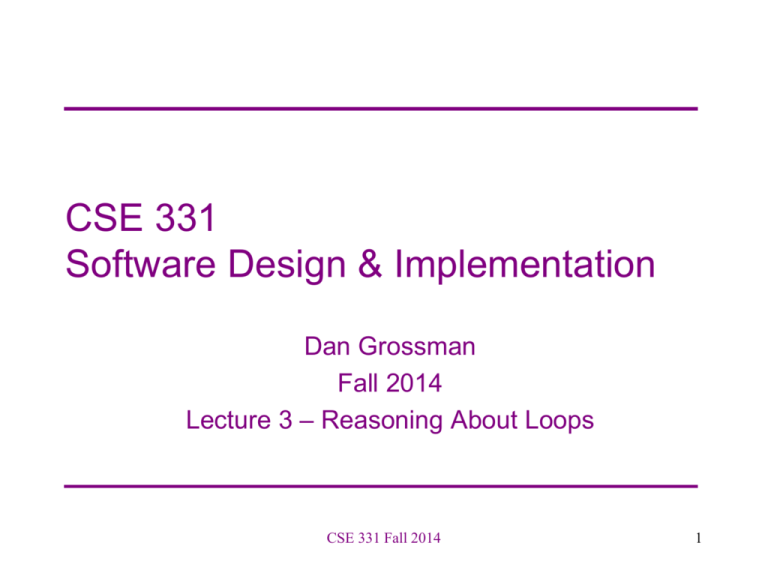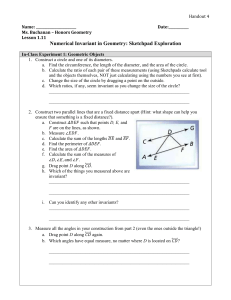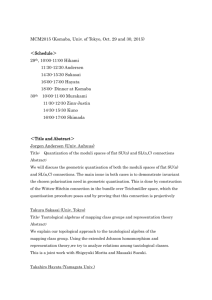CSE 374 Programming Concepts & Tools
advertisement

CSE 331
Software Design & Implementation
Dan Grossman
Fall 2014
Lecture 3 – Reasoning About Loops
CSE 331 Fall 2014
1
Reasoning about loops
So far, two things made all our examples much easier:
1. When running the code, each statement executed 0 or 1 times
2. (Therefore,) trivially the code always terminates
Neither of these hold once we have loops (or recursion)
– Will consider the key ideas with while-loops
– Introduces the essential and much more general concept of
an invariant
– Will mostly ignore prove-it-terminates; brief discussion at end
CSE 331 Fall 2014
2
Informal example
As before, consider high-level idea before the precise Hoare-triple
definitions
// assume: x >= 0
y = 0; i=0;
// x >= 0 ∧ y = 0 ∧ i = 0
// invariant: y = sum(1,i)
while(i != x) {
// y = sum(1,i) ∧ i != x
i = i+1;
// y = sum(1,i-1)
y = y+i;
// y = sum(1,i-1)+i
}
// i=x ∧ y = sum(1,i)
// assert: y = sum(1,x)
CSE 331 Fall 2014
3
Key lessons
• To reason about a loop (that could execute any number of
iterations), we need a loop invariant
• The precondition for the loop must imply the invariant
– (Precondition stronger than (or equal to) invariant)
• Invariant plus loop-test-is-true must be enough to show the
postcondition of the loop body also implies the invariant (!)
• Invariant and loop-test-is-false must be enough to show the
postcondition of the loop
CSE 331 Fall 2014
4
The Hoare logic
• Consider just a while-loop (other loop forms not so different)
{P} while B S {Q}
Such a triple is valid if there exists an invariant I such that:
• P => I
invariant must hold initially
• {I ∧ B}S{I}
body must re-establish invariant
• (I ∧ !B) => Q
invariant must establish Q if test-is-false
The loop-test B, loop-body S, and loop-invariant I “fit together”:
– There is often more than one correct loop, but with possibly
different invariants
Note definition “makes sense” even in the zero-iterations case
CSE 331 Fall 2014
5
Example, more precisely
{P} while B S {Q}
• P => I
• {I ∧ B}S{I}
• (I ∧ !B) => Q
invariant must hold initially
body must re-establish invariant
invariant must establish Q if test-is-false
{x >= 0}
y = 0; i=0;
{pre: x >= 0 ∧ y = 0 ∧ i = 0}
{inv: y = sum(1,i)}
while(i != x) {
i = i+1;
y = y+i;
}
{post: i=x ∧ y = sum(1,i)}
(so: y = sum(1,x))
CSE 331 Fall 2014
6
A different approach
A different loop has a different invariant
{x >= 0}
y = 0; i=1;
{pre: x >= 0 ∧ y = 0 ∧ i = 1}
{inv: y = sum(1,i-1)}
while(i != x+1) {
y = y+i;
i = i+1;
}
{post: i=x+1 ∧ y = sum(1,i-1)}
(so: y = sum(1,x))
CSE 331 Fall 2014
7
And find bugs
And this third approach doesn’t do what we want
{x >= 0}
y = 0; i=1;
{pre: x >= 0 ∧ y = 0 ∧ i = 1}
{inv: y = sum(1,i-1)}
while(i != x) {
y = y+i;
i = i+1;
}
{post: i=x ∧ y = sum(1,i-1)}
(so: y = sum(1,x))
CSE 331 Fall 2014
8
More bugs
• And this approach has an invalid Hoare triple hidden in it
{x >= 0}
y = 0; i=0;
{pre: x >= 0 ∧ y = 0 ∧ i = 0}
{inv: y = sum(1,i)}
while(i != x) {
y = y+i;
i = i+1;
// invariant not satsified – why?
}
{post: i=x ∧ y = sum(1,i)}
CSE 331 Fall 2014
9
Neither too strong nor too weak
• If loop invariant is too strong, it could be false!
– Won’t be able to prove it holds either initially or after loop-body
• If loop invariant is too weak, it could
– Leave the post-condition too weak to prove what you want
– And/or be impossible to re-establish after the loop body
• This is the essence of why there is no complete automatic
procedure for conjuring a loop-invariant
– Requires thinking (or, sometimes, “guessing”)
– Often while writing the code
– If proof doesn’t work, invariant or code or both may need work
• There may be multiple invariants that “work” (neither too strong
nor too weak), with some easier to reason about than others
CSE 331 Fall 2014
10
A methodology
• Fortunately, programming is creative and inventive!
• Here, this means coming up with a loop and its invariant
• Won’t advocate a hard-and-fast rule, but do want to avoid the
natural approach of “always code first, dream up invariant second”
• Instead, often surprisingly effective to go in this order:
1. Think up the invariant first, have it guide all other steps (!)
• What describes the milestone of each iteration?
2. Write a loop body to maintain the invariant
3. Write the loop test so false-implies-postcondition
4. Write initialization code to establish invariant
CSE 331 Fall 2014
11
Example
Set max to hold the largest value in array items
1. Think up the invariant first, have it guide all other steps
– Invariant: max holds largest value in range 0..k-1 of items
– Other approaches possible: Homework 2
CSE 331 Fall 2014
12
Example
Set max to hold the largest value in array items
2.
Write a loop body to maintain the invariant
{inv: max holds largest value in items[0..k-1]}
while( ) {
// inv holds
if(max < items[k]) {
max = items[k]; // breaks inv temporarily
} else {
// nothing to do
}
// max holds largest value in items[0..k]
k = k+1; // invariant holds again
}
CSE 331 Fall 2014
13
Example
Set max to hold the largest value in array items
3.
Write the loop test so false-implies-postcondition
{inv: max holds largest value in items[0..k-1]}
while(k != items.size) {
// inv holds
if(max < items[k]) {
max = items[k]; // breaks inv temporarily
} else {
// nothing to do
}
// max holds largest value in items[0..k]
k = k+1; // invariant holds again
}
CSE 331 Fall 2014
14
Example
Set max to hold the largest value in array items
4.
Write initialization code to establish invariant
k=1;
max = items[0];
{inv: max holds largest value in items[0..k-1]}
while(k != items.size) {
…
}
CSE 331 Fall 2014
15
Edge case
• Our initialization code has a precondition: items.size > 0
{items.size > 0}
k=1;
max = items[0];
{inv: max holds largest value in items[0..k-1]}
while(k != items.size) {
…
}
• Such a (specified!) precondition may be appropriate
• Else need a different postcondition (“if size is 0, …”) and a
conditional that checks for the empty case
– Or the Integer.MIN_VALUE “trick” and logical reasoning
• Neat: Precise preconditions should expose all this to you!
CSE 331 Fall 2014
16
More examples
• Here:
– Quotient and remainder
– “Dutch national flag problem” (like Homework 0)
• More in reading notes:
– Reverse an array (have to refer to “original” values)
– Binary search (invariant about range of array left to search)
• More on Homework 2:
– Enjoy!
CSE 331 Fall 2014
17
Quotient and remainder
Set q to be the quotient of x / y and r to be the remainder
Pre-condition: x > 0 ∧ y > 0
Post-condition: q*y + r = x ∧ r >= 0 ∧ r < y
A possible loop invariant: q*y + r = x ∧ r >= 0
A loop body that preserves the invariant:
q = q + 1;
r = r – y;
The loop test that given the invariant implies the post: y <= r
Initialization to establish invariant: q = 0; r = x;
CSE 331 Fall 2014
18
Put it all together
{x > 0 ∧ y > 0} // can this be weakened?
r = x;
q = 0;
{inv: q*y + r = x ∧ r >= 0 }
while (y <= r) {
q = q + 1;
r = r – y;
}
{q*y + r = x ∧ r >= 0 ∧ r < y}
CSE 331 Fall 2014
19
Dutch National Flag (classic example)
Given an array of red, white, and blue pebbles, sort the array so the
red pebbles are at the front, white are in the middle, and blue are at
the end
– [Use only swapping contents rather than “count and assign”]
Edsgar Dijkstra
CSE 331 Fall 2014
20
Pre- and post-conditions
Precondition: Any mix of red, white, and blue
Mixed colors: red, white, blue
Postcondition:
– Red, then white, then blue
– Number of each color same as in original array
Red
White
CSE 331 Fall 2014
Blue
21
Some potential invariants
Any of these four choices can work, making the array more-andmore sorted as you go:
Red
White
Blue
Mixed
Red
White
Mixed
Blue
Red
Mixed
White
Blue
Mixed
Red
White
Blue
Middle two slightly better because at most one swap per iteration
instead of two
CSE 331 Fall 2014
22
More precise, and then some code
• Precondition P: arr contains r reds, w whites, and b blues
• Postcondition: P ∧ 0 <= i <= j <= arr.size
∧ arr[0..i-1] is red
∧ arr[i..j-1] is white
∧ arr[j..arr.size-1] is blue
• Invariant: P ∧ 0 <= i <= j <= k <= arr.size
∧ arr[0..i-1] is red
∧ arr[i..j-1] is white
∧ arr[k..arr.size-1] is blue
• Initializing to establish the invariant (could do before or after
body): i=0; j=0; k=arr.size;
CSE 331 Fall 2014
23
The loop test and body
Red
White
i
Mixed
j
while(j!=k) {
if(arr[j] == White) {
j = j+1;
} else if (arr[j] == Blue) {
swap(arr,j,k-1);
k = k-1;
} else { // arr[j] == Red
swap(arr,i,j)
i = i + 1;
j = j+1;
}
}
CSE 331 Fall 2014
Blue
k
void swap(int[] x,
int y,
int z) {
int tmp = x[y];
x[y] = x[z];
x[z] = tmp;
}
24
Aside: swap
• Reading notes write swap(a[i],a[j]) and such
• This is not implementable in Java
– But fine pseudocode
– Great exercise: Write a coherent English paragraph why it is
not implementable in Java (i.e., does not do what you want)
• You can implement swap(a,i,j) in Java
– So previous slide and Homework 2 do it that way
CSE 331 Fall 2014
25
When to use proofs for loops
• Most loops are so “obvious” that proofs are, in practice, overkill
– for(String name : friends) {…}
• Use logical reasoning when intermediate state (invariant) is
unclear or edge cases are tricky or you need inspiration, etc.
• Use logical reasoning as an intellectual debugging tool
– What exactly is the invariant?
– Is it satisfied on every iteration?
– Are you sure? Write code to check?
– Did you check all the edge cases?
– Are there preconditions you did not make explicit?
CSE 331 Fall 2014
26
Termination
• Two kinds of loops
– Those we want to always terminate (normal case)
– Those that may conceptually run forever (e.g., web-server)
• So, proving a loop correct usually also requires proving
termination
– We haven’t been proving this: might just preserve invariant
forever without test ever becoming false
– Our Hoare triples say if loop terminates, postcondition holds
• How to prove termination (variants exist):
– Map state to a natural number somehow (just “in the proof”)
– Prove the natural number goes down on every iteration
– Prove test is false by the time natural number gets to 0
CSE 331 Fall 2014
27
Termination examples
• Quotient-and-remainder: r (starts positive, gets strictly smaller)
• Binary search: size of range still considered
• Dutch-national-flag: size of range not yet sorted (k-j)
• Search in a linked list: length of list not yet considered
– Don’t know length of list, but goes down by one each time…
– … unless list is cyclic in which case, termination not assured
CSE 331 Fall 2014
28









